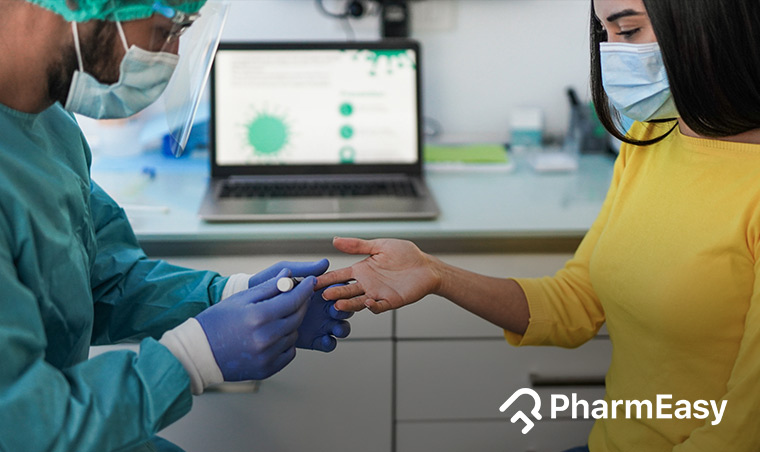Does COVID-19 Increase The Risk Of Developing Diabetes?
By Shantanu Sodhi +2 more

Get insightful and
helpful tips to treat
your symptoms for FREE



Download PharmEasy App




Register to Avail the Offer
Send OTPBy continuing, you agree with our Privacy Policy and Terms and Conditions
By Shantanu Sodhi +2 more
With so many resources going into understanding COVID-19, it seems like every day we get new surprising information about its effects on us. Diabetes after COVID-19 is the latest complication that may soon be getting a lot of scrutiny by the medical community. The two conditions are not directly related: one is a disease caused by a virus and the other is a metabolic disease.

There isn’t a clear answer yet but hospitals and doctors are doing their best to check if there is indeed a link between COVID-19 and increased diabetes cases. A few studies suggest that between 5% to 14.4% of COVID-19 patients went on to also develop diabetes later on. Is it possible that you have a higher risk of diabetes after COVID-19 recovery? The answer is a bit complicated so let’s dive right in:
Diabetics can surely be vaccinated with Covid 19 vaccine, it is not contraindicated and can in fact be useful to prevent complications as diabetics are more vulnerable to developing severe illness post covid.
Dr. Ashish Bajaj – M.B.B.S, M.D.
Table of Contents
Type I diabetes is when the pancreas produces very little or no insulin for the body to use. So then, what is type 2 diabetes? Type 2 diabetes is a metabolic disorder that develops when insulin is being produced but is not being used by the body (also called insulin resistance). Insulin is required by the body to metabolise glucose (sugar) in the bloodstream. When insulin is absent or unused then the levels of sugar in the blood keeps rising since it has nowhere to go.
Caused by the Coronavirus called SARS-CoV-2, COVID-19 is a respiratory disease. The infection can present as mild with minor flu or cold-like symptoms (or no symptoms). It is easily spread through contact with an infected person or through air droplets in the environment. In some people (especially elders and those with poor immunity) it can lead to severe illness (including high fever, respiratory distress and even death ).
These two things do not seem similar in any way, so why are some people developing diabetes after COVID-19?
Convincing evidence indicates that viruses are associated with T1D development and progression. During the COVID-19 pandemic, cases of hyperglycemia, diabetic ketoacidosis, and new diabetes increased, suggesting that SARS-CoV-2 may be a trigger for or unmask T1D.
Dr. M.G. Kartheeka, MBBS, MD
So it is possible that many of the people who are getting diagnosed with diabetes after COVID-19 are simply discovering preexisting conditions. This may be due to better/more frequent testing during the COVID-19 infection or treatment leading to the diagnosis of diabetic conditions that would have otherwise remained hidden.
This emphasizes the need for us to be completely aware of prediabetes symptoms and signs of diabetes in men and signs of diabetes in women, which can help in early diagnosis, and consequently more effective treatment options.
Some of these may also be associated with normal recovery, so do not panic if you notice them. But consider running these by your doctor just to be safe.
Here are a few symptoms to keep an eye out for that may indicate diabetes:
Also Read: Omicron Variant: Latest News & Updates
While we still do not know if there is indeed a relation between these two conditions, there are still a few things to keep in mind. First, if you are overweight or obese try to healthily lose a few kilos. If you have already lost weight due to COVID-19 do not try to lose more weight, instead, work with your doctor to get back to a healthy weight, make changes to your diet and cut out unhealthy, processed foods. Lastly, get yourself tested for diabetes at the earliest especially if you have just recovered from COVID-19. In any case, do not panic, consult your doctors and understand the best possible way to manage the condition for yourself as the modality of treatment varies from person to person.
Disclaimer: The information provided here is for educational/awareness purposes only and is not intended to be a substitute for medical treatment by a healthcare professional and should not be relied upon to diagnose or treat any medical condition. The reader should consult a registered medical practitioner to determine the appropriateness of the information and before consuming any medication. PharmEasy does not provide any guarantee or warranty (express or implied) regarding the accuracy, adequacy, completeness, legality, reliability or usefulness of the information; and disclaims any liability arising thereof.
Links and product recommendations in the information provided here are advertisements of third-party products available on the website. PharmEasy does not make any representation on the accuracy or suitability of such products/services. Advertisements do not influence the editorial decisions or content. The information in this blog is subject to change without notice. The authors and administrators reserve the right to modify, add, or remove content without notification. It is your responsibility to review this disclaimer regularly for any changes.

Leave your comment...
Comments